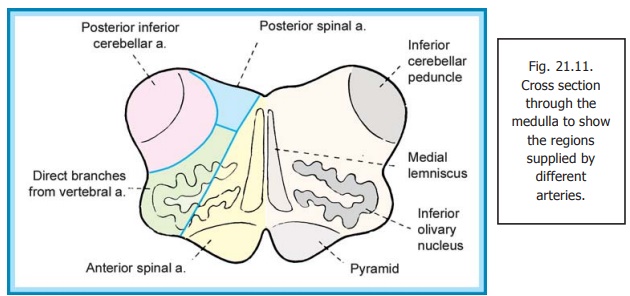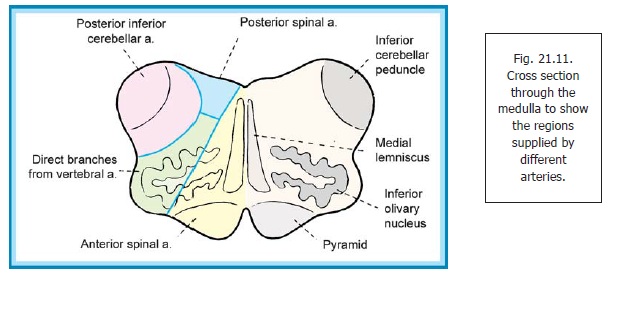Chapter: Human Neuroanatomy(Fundamental and Clinical): Blood Supply of Central Nervous System
Arterial Supply of the Brainstem - Blood Supply of Central Nervous System

Arterial Supply of the Brainstem
Medulla
The medulla is supplied by various branches of the vertebral arteries. These are the anterior and posterior spinal arteries, the posterior inferior cerebellar artery, and small direct branches (Fig. 21.11). The anterior spinal artery supplies a triangular area next to the midline. This area includes the pyramid, the medial lemniscus, and the hypoglossal nucleus. The posterior spinal artery supplies a small area including the gracile and cuneate nuclei. The posterior inferior cerebellar artery supplies the retro-olivary region. This region contains several important structures including the spinothalamic tracts, the rubrospinal tract, the nucleus ambiguus, the dorsal vagal nucleus, and descending autonomic

fibres. The posterior inferior cerebellar artery also supplies part of the inferior cerebellar peduncle. The rest of the medulla is supplied by direct bulbar branches of the vertebral arteries.
Clinical:
Thrombosis in an artery supplying the medulla produces symptoms depending upon the structures involved. Two characteristic syndromes are the medial medullary syndrome produced by thrombosis in the anterior spinal artery, and the lateral medullary syndrome produced by thrombosis in the posterior inferior cerebellar artery.
In the medial medullary syndrome the ventral and medial part of the medulla is damaged. Involvement of corticospinal fibres (pyramids) leads to contralateral hemiplegia. Damage to the hypoglossal nucleus leads to ipsilateral (lower motor neuron type of) paralysis of muscles of the tongue. Involvement of the medial lemniscus leads to loss of the sensation of fine touch, sense of movement and sense of position.
In the lateral medullary syndrome the structures damaged include the following.
1. Damage to the lateral spinothalamic tract leads to contralateral loss of sensations of pain and temperature.
2. Damage to the spinal nucleus and tract of the trigeminal nerve leads to loss of sensations of pain and temperature over the region supplied by the trigeminal nerve.
3. Damage to the nucleus ambiguus leads to difficulty in swallowing (dysphagia) and in speech (dysarthria).
4. Damage to the cerebellum and to the inferior cerebellar peduncle causes loss of equilibrium (ataxia) and giddiness.
5. Involvement of descending autonomic fibres leads to Horner’s syndrome.
Pons
The pons is supplied by branches from the basilar artery. The medial portion of the ventral part of the pons is supplied by paramedian branches. The lateral portion of the ventral part is supplied by short circumferential branches. The dorsal part of the pons is supplied by long circumferential branches. The dorsal part also receives branches from the anterior inferior cerebellar and superiorcerebellar arteries. The paramedian branches of the basilar artery may extend into this region from the ventral part of the pons.
Pontine haemorrhage
Haemorrhage into the pons leads to coma (and is often fatal). The reticular formation, autonomic nervous system and the hypothalamus are affected. Apart from coma the condition is marked by pin point pupils and hyperpyrexia Bilateral facial paralysis and paralysis of all four limbs can occur if the haemorrhage is extensive.
Midbrain
The midbrain is supplied mainly by branches of the basilar artery. These are the posterior cerebral and superior cerebellar arteries and direct branches from the basilar artery. Branches are also received from the posterior communicating and anterior choroidal arteries. Branches arising from these vessels may either be paramedian, which supply parts near the midline; or circumferential which wind round the midbrain to supply lateral and dorsal parts. One of the latter arteries is called the quadrigeminal artery. It is the main source of blood to the colliculi.
Arteries Supplying the Cerebellum
The superior surface of the cerebellum is supplied by the superior cerebellar branches of the basilar artery. The anterior part of the inferior surface is supplied by the anterior inferior cerebellar branches of the same artery. The posterior part of the inferior surface is supplied by the posteriorinferior cerebellar branch of the vertebral artery.
Related Topics